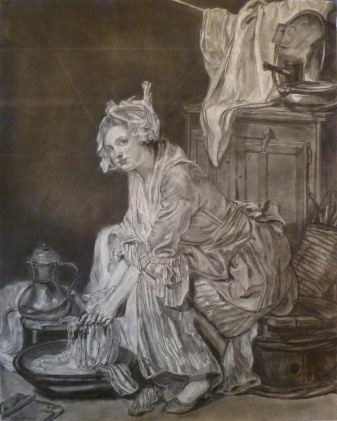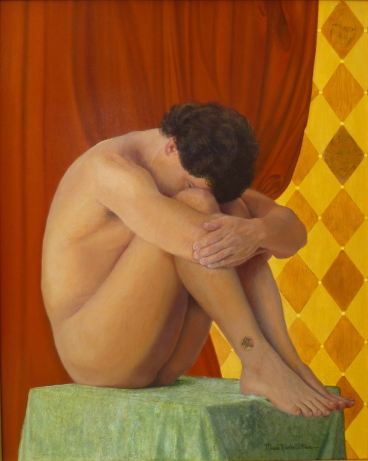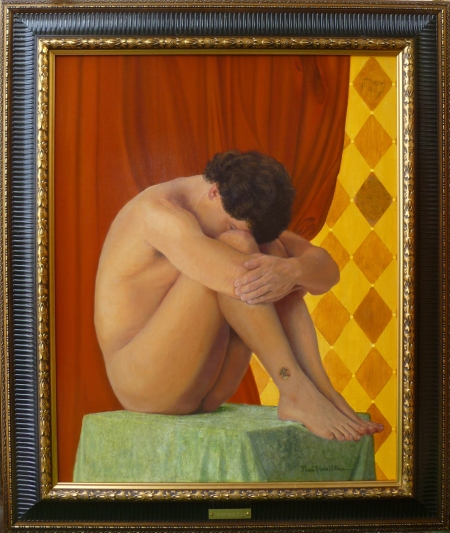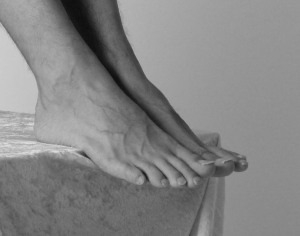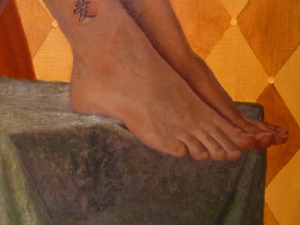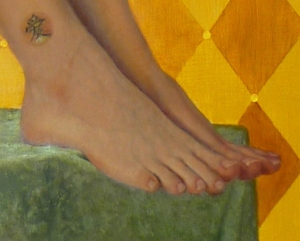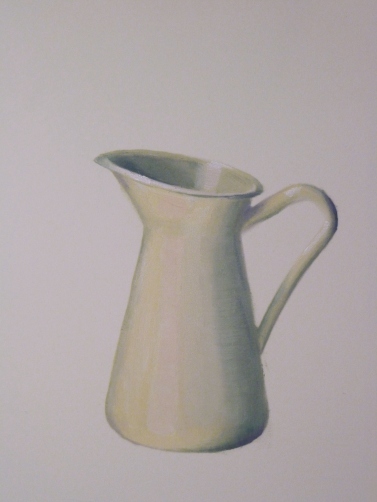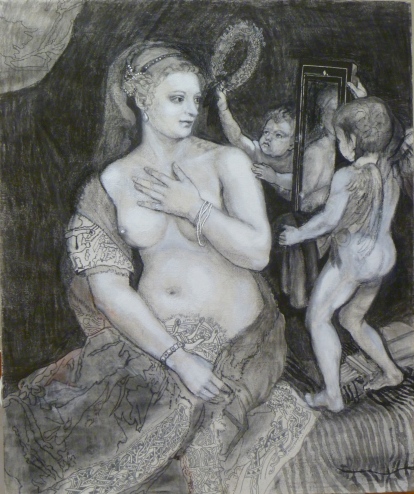Since Aristotle was the first person we know of that gave serious, objective thought to the rainbow and rainbow color theory, it behooves us as artists to contemplate it as well. This instruction is written as though the artist is new to the concepts of painting in spectrum white color, and approaching the process for the first time. Thus, I apologize in advance if what follows seems overly simplistic, but these details may prove helpful to some.
Firstly, two important points should be mentioned here:
1) When mixing the greyscale, this is how to get a true, neutral set of greys; otherwise, they will tend toward blue: adding just the barest touch of raw umber to the black pile of paint on your palette is important. Preferably use mars black, as it is generally less blue than ivory black. Then lighten a small bit of it to check that you have not added too much umber—this will make it look dirty if you have, and you do not want the whole pile polluted.
2) Although the tube colors for white spectrum are customary for the purposes of demonstration, they are still somewhat flexible. For example, you may find that you have manganese violet in your paint box but not cobalt violet; or you may find that your garment is in a warmer light setting and you would prefer using a violet commensurate with that. It is okay.
It Always Goes Back To Values
However, despite guides and formulae, you must still understand why you are choosing to paint with spectrum white, and be able to determine your darkest and lightest values in the three situations/conditions outlined below: *Light, Shadow, and Sunset. After determining the situation, you look at the garment and think like this: “My darkest dark is a value 3 so, since purple is first on the rainbow spectrum (following their order) and comes out of the tube at value 1, I will lighten my purple with white until it is a value 3. Then, I can tint some grey with it, which should result in a purple-ish white value 3. The next color in the spectrum is ultramarine, so I will lighten that color to a value 4, and then mix it with a value 4 grey,” and so on, up the spectrum.
Remember that, ultimately, we don’t want the whites on our paintings to be white, but we want to portray a colorful rainbow spectrum that viewers perceive as white, thereby adding an almost otherworldly glow and sparkle. However, avoid excessive color in the greyscale. We want the viewer to remark, “What a vibrant white dress!” not, “Look at all the colors in that dress—what is that supposed to be?”
Paint Mixing
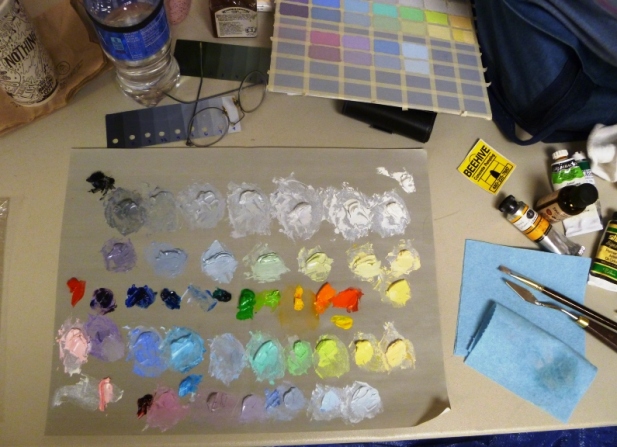
Situation 1: Here are the Munsell/rainbow spectrum colors in the light, by name, from dark to light, and their oil paint equivalents:
- (*1) Purple —Cobalt Violet (or Dioxazine Purple, or Ultramarine Blue+Alizarin Crimson Perm.)
- (*1) Purple-Blue —Ultramarine Blue
- (*3 or 4) Blue —Cerulean Blue (or Phthalo Blue+Phthalo Green)
- (*1) Blue-Green —Viridian Green (or Phthalo Green)
- (*5) Green —Cadmium Green (or Hansa Yellow+Viridian)
- (*8) Yellow-Green —Phthalo Yellow Green (or extra Hansa Yellow+Viridian)
- (*9) Yellow —Cadmium Yellow Lt.
- (*7) Yellow-Red —Cadmium Orange
- (*4 1/2) Red —Napthol Red Lt.
- (*1) Red-Purple —Alizarin Crimson Permanent (or Phthalo Rose)
–Titanium White
–Mars Black
*numbers indicate the value of the color, directly out of the paint tube
Situation 2: The oil paint colors to use for spectrum white in shadow, dark to light, are:
- Alizarin Crimson Permanent (or Phthalo Rose)
- Cobalt Violet (or Dioxazine Purple, or Ultramarine Blue+Alizarin Crimson Perm.)
- Ultramarine Blue
- Cerulean Blue (or a mixture of Phthalo Blue+Phthalo Green)
Situation 3: Finally, although it may seem strange to start in the middle of the spectrum with Cerulean as the darkest value, the list still follows the spectrum order. The oil paint colors to use for sunsets, seascapes, or snow, dark to light, are:
- Cerulean Blue (or a mixture of Phthalo Blue+Phthalo Green)
- Ultramarine Blue
- Cobalt Violet (or Dioxazine Purple, or Ultramarine Blue+Alizarin Crimson Perm.)
- Alizarin Crimson Permanent (or Phthalo Rose)
- Napthol Red Lt.
- Cadmium Orange
- Cadmium Yellow Lt.
Here is the resulting color chart, and the explanation of each row of the chart:
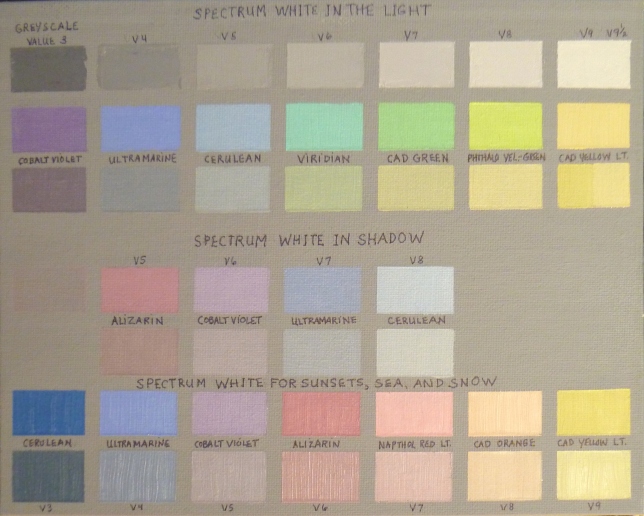
Situation 1
Row 1, Greyscale, V3-9
Row 2, each color lightened to match respective grey values
Row 3, the result of mixing greys with respective color values
Situation 2
Row 2, lightened to match grey values 5-8
Row 3, the result of mixing greys with respective color values
Situation 3
Row 2, each color lightened to match respective grey values from row 1
Row 3, the result of mixing greys with respective color values
A note here—Sometimes you will need half-steps in your values, so keep in mind that just because you have only 4 colors to use for shadows (for example), does not mean you necessarily have only 4 values to address in your white shadows. You may have 5 or more values in your shadows, so you simply spread these four colors to a broader value range, commensurate with the needs of your painting. The same holds true for the other two situations outlined above.
We must also keep in mind the concept of “reflected light” as it relates to white objects and how they will be affected. Everything that is near your white object or garment, whether it is an apple or a curtain, will be reflected somewhere in that white object or garment, so a way to handle those reflected lights might be to gently glaze the reflected light color on top of the painted spectrum white object after it dries. Of course, the handling of this will be very painting-specific, and the way you accomplish it for one painting, might not be the same for the next, but it is something to keep in mind.
Now What? Analyze which situation applies to your painting, then paint it from dark to light using these instructions. In a previous post, I have painted a quick example on the use of spectrum white that might be a useful reference.
*A big “thank you” goes to Charlene Higley for differentiating and fine-tuning these three conditions.
